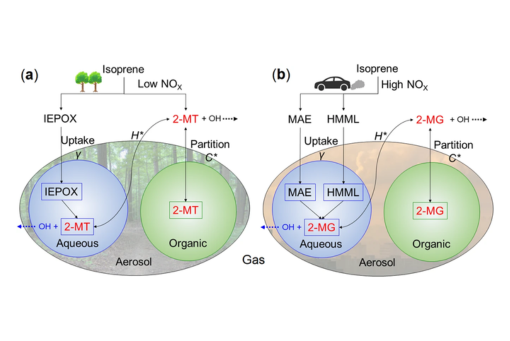New formation and fate of Isoprene SOA markers revealed by field data-constrained modeling
Abstract
Particulate 2-methyltetrols (2-MT) and 2-methylglyceric acid (2-MG) are typically used to indicate the abundance of isoprene-derived secondary organic aerosols (SOA). However, their formation and fate are not fully understood. In this study, we showed that particulate 2-MT and 2-MG collected at multiple monitoring sites under a wide range of atmospheric and emission conditions, with concentrations spanning six orders of magnitudes, are well reproduced with an expanded isoprene-SOA scheme implemented into the Community Multiscale Air Quality (CMAQ) model. The scheme considers their three-phase (gas-aqueous-organic phase) partitioning, formation from acid-driven multiphase reactions, and degradation by OH radicals in the gas and aqueous phases. The model results reveal that a non-aqueous formation pathway or direct biogenic emission is needed to supplement the commonly assumed acid-driven multiphase reaction process to explain the observed 2-MT concentrations. This missing pathway contributes to 20–40% of 2-MT in areas with aerosol pH<2 and more than 70% under less acidic conditions (pH~2–5), such as those encountered in the western US and China. The typical summertime gas-phase photochemical lifetimes of 2-MT and 2-MG are estimated to be 4–6 and 20–30 h, respectively, and their aqueous lifetimes are approximately 20–40 h. Our simulations show that predicted 2-MT is mainly influenced by its aqueous phase loss to OH, but 2-MG is more sensitive to gas phase OH loss due to the preferential partitioning of the two tracers in the aqueous and gas phases, respectively.
Citation
Zhang, J., Liu, J., Ding, X., He, X., Zhang, T., Zheng, M., Choi, M., Isaacman-VanWertz, G., Yee, L., Zhang, H., Misztal, P., Goldstein, A. H., Guenther, A. B., Budisulistiorini, S. H., Surratt, J. D., Stone, E. A., Shrivastava, M., Wu, D., Yu, J. Z., & Ying, Q. (2023). New formation and fate of isoprene SOA markers revealed by field data-constrained modeling. Npj Climate and Atmospheric Science, 6(1). https://doi.org/10.1038/s41612-023-00394-3


